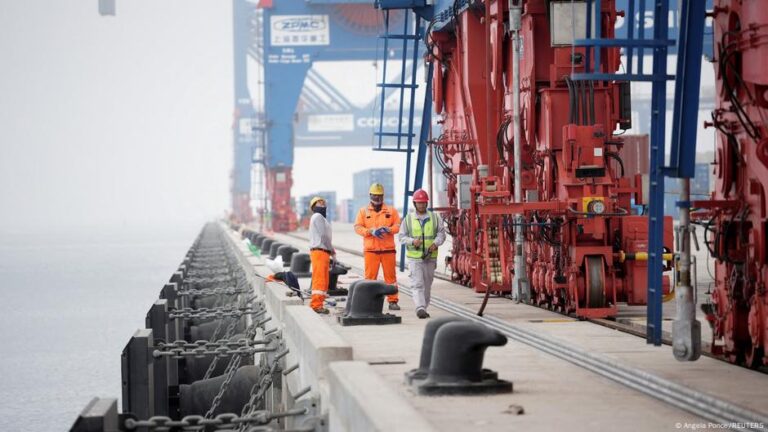Latin America’s largest economy, Brazil, is planning a major rail link to Peru’s Chancay megaport on the Pacific — a project backed by Chinese financing with the aim of reconfiguring the Asian powerhouse’s trade routes and reduce dependency on traditional Atlantic shipping lanes. Brazilian business magazine Valor wrote recently that Chinese interest in new investments in Brazil is on the rise.
Colombia, too, is reportedly weighing participation in China’s so-called Belt and Road Initiative, and Venezuela is actively pursuing deeper ties with Chinese oil firms.
These developments in Latin America suggest that US trade policies under President Donald Trump — especially the imposition of punitive tariffs on almost the whole world — appear to be nudging Latin America closer to Beijing rather than pushing it away.
On Tuesday, Chinese President Xi Jinping offered billions of dollars to Latin America and the Caribbean.
China will disburse 66 billion yuan ($9.2 billion, €8.2 billion) in credit to the Community of Latin American and Caribbean States’ (CELAC) members, Xi told delegates from around 30 nations gathered in Beijing for the three-yearly China-CELAC Forum Ministerial Meeting.
China plays the long game
Amid the turbulence of the US-China trade war, China’s consistent strategy is standing in sharp contrast to Washington’s erratic approach, argues Vladimir Rouwinski, adding that, “what Latin America needs most right now is clarity.”
“What we’re seeing instead is uncertainty, constant changes, and a lack of clear rules,” Rouwinski, an associate professor at Icesi University in Cali, Colombia, told DW, referring to the constant shifts in US policy that make it difficult for Latin American governments to adapt.
China, on the other hand, appears committed to its long-term strategy, he added, because it’s “not likely” to change its strategies from one week to the next. “There is, however, the possibility that China may expand its presence quickly and use Latin America as a strategic pillar.”
A US trust gap in the region
Enrique Dussel-Peters, coordinator of the China-Mexico Studies Center at the UNAM university in Mexico City, sees a growing trust gap. In an interview with DW, he noted that China has been “very active” for decades in its cooperation strategy with the so-called Global South.
Just in March this year, said Dussel-Peters, Chinese Foreign Minister Wang Yi underscored the importance of the China-Latin America relationship during a visit, describing it as one based on mutual respect, equality, and mutual benefit. “The contrast with the executive orders issued by the US president since taking office in January couldn’t be starker,” he added.
Trade, investment, and infrastructure projects with China now have a significant impact on Latin America and the Caribbean. “In the current confrontation between the US and China, Beijing has proven to be the more reliable and long-term partner,” he said.
US sees problems, China sees opportunities
Mauricio Santoro, a Brazilian political scientist, thinks that the two superpowers have fundamentally different perspectives on countries in the region.
“The US government sees Latin America as a problem. The Chinese government sees it as a region full of economic opportunities,” the author of a book titled Brazil-China Relations in the 21st Century, told DW. This framing, he added, has been recurring at least since the beginning of the century, but has intensified under the Trump administration with its focus on trade, migration, and organized crime.
“Washington’s agenda for the region is highly negative, focused on problems, and offers little in the way of mutually beneficial agreements or long-term prospects,” Santoro said.
Caught in the middle, but leaning East
Still, Latin American countries are not ready to pick sides, says Santoro. “They don’t want — and can’t afford — to choose between the US and China.” Both remain critical trading partners. But the trend, he said, is clear: US influence is fading, and China’s is growing.
China’s trade with the region has surged dramatically in recent decades. With Brazil, for example, bilateral trade has risen from $1 billion (€903 million) in 2000 to over $130 billion today.
“Traditional US tools of influence — such as economic pressure — are becoming less effective, particularly with larger nations like Brazil, Mexico, and Argentina,” Santoro noted.
That is why Brazilian business journalist and author Gilvan Bueno sees Latin America as an increasingly important part of China’s global trade strategy.
“Latin America will move more into the focus of China as it develops new strategies and diversifies geopolitically to reduce its dependence on the American economy,” he told DW.
That’s where Latin America — and Africa — come in. With robust demand and underdeveloped infrastructure, both regions offer Beijing a chance to absorb excess production and offset export losses.
This article was originally written in German.


